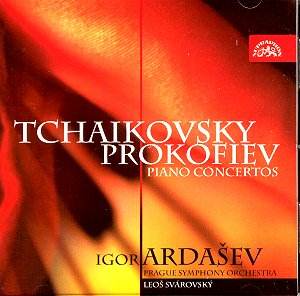The
more unusual offering on this new Supraphon disc is Tchaikovsky’s
Concert Fantasia in G major. Although composed between the 4th
and 5th Symphonies when Tchaikovsky was at the top
of his musical powers, the Concert Fantasia has received very
little exposure. One reason is that the work does not have the
title of ‘Piano Concerto’. Tchaikovsky very much desired this
title, but the two-movement structure mandated a different ‘moniker’.
Another reason is that the form of the work does not carry the
structural or emotional logic one finds in Tchaikovsky’s most
popular creations. Putting matters of structure and title aside,
the Concert Fantasia is a fine piece with many thrilling and stirring
passages and themes.
The
1st Movement of the Concert Fantasia is particularly
rewarding. You won’t find a more exciting and exuberant first
3-˝ minutes of music than offered in the first subject. Also,
this first subject exhibits one of the most compelling aspects
of the great composers, taking the listener to great heights not
thought possible and then raising the bar even further as if a
supernatural mother-ship was propelling us to transcendental wonders.
That’s exactly what Tchaikovsky does in the first subject. His
tremendous surge of energy gets an additional boost when an exploding
piano part punctuated by the orchestra grabs hold of our senses
and electrifies our nerve-endings [tr. 1 2.35].
The
Ardašev version is a fine alternative to the excellent offering
from Mikhail Pletnev. Ardašev and Svárovský impart
greater drive to the Concert Fantasia than Pletnev and Fedoseyev
who are the more exuberant performers. It is essentially a matter
of drive versus lift, and I wouldn’t want to be without either
performance.
The
Concert Fantasia does have its bombastic moments, and Pletnev
plays them to the hilt as if he is competing with the score for
highest number of bombastic points. I much prefer that Ardašev
injects sincere human urges at these moments and largely avoids
the unrealistic and over-wrought route taken by Pletnev.
Pletnev
and Fedoseyev enjoy the superior soundstage. There is an attractive
bloom to their recording that even applies at low volumes. In
contrast, the Ardašev soundstage is rather dry with a noticeable
bloom only taking hold at high volume levels. Overall, the pros
and cons of the recordings and performances tend to balance one
another.
Prokofiev’s
Piano Concerto in G minor is a product of his student period when
he was considered a rebellious student straying too far from the
traditional fold. Critics at the time had a field day when Prokofiev
premiered the work, saying it "has nothing in common with
civilized music" and referring to it as "a Babel of
insane sounds".
Of
course, times have moved on as have musical tastes, and the Concerto
in G minor no longer sounds alien to the enjoyment of music. However,
it is a powerful and stark work with sharp and frantic expressions
mixed with a basic lyricism that wins the day.
Among
its distinctive elements is perhaps the longest 1st
Movement cadenza in any piano concerto written to date. Not only
the longest cadenza, it might also be the most powerful one as
well. At its conclusion, the orchestra led by the brass section
bellows out so strongly that it sounds as if all of God’s fury
is being unleashed upon the Earth. Not surprisingly, this cadenza
is often referred to as the "Cadenza from Hell".
The
2nd Movement is a true ‘moto-perpetuo’ without even
a hint of a rest. This is brilliant material that streaks through
the sky; the form is brittle but never breaks. Brutality takes
center stage at the outset of the 3rd Movement, and
it is easy to understand how stunned that early 20th
century audience might have been. Even more perplexing must have
been the first theme of the 4th Movement with its frenetic
display, which is however given over to a second theme of dark
lyricism.
The
primary reason I cite the comparison versions from Feltsman and
Krainev is their divergent views of the work. Feltsman and the
orchestra prioritize the poetry of the music with some reduction
in conveying its darkest regions and modernist tendencies. Although
a relatively romanticized account, the Feltsman version is very
attractive and possesses fine rhythm. Krainev and Kitaenko offer
us the sleek industrial-strength interpretation, fully bringing
us the technical advances of the early 20th century;
their message is that there is much work to do in order to keep
up with the modern age and no time for sentimental thoughts.
Ardašev
is a cross between Feltsman and Krainev, providing the best that
each has to offer. Sleek and shimmering one moment, powerful and
bleak the next, Ardašev is always at the service of Prokofiev’s
music. I especially love his lyricism and growing urgency in the
second theme of the final movement [tr. 6 2.23].
I’m
not as enthusiastic about Svárovský’s conducting.
He isn’t as willing as Ardašev to plumb the depths of human despair.
He also does not summon that last ounce of all-powerful tension
to the conclusion of the 1st Movement cadenza [tr.
3 10.52].
In
summary, Igor Ardašev is the star of this Supraphon recording.
Born in 1967, he is on the threshold of a wonderful career and
already is receiving frequent praise for his recordings and concert
appearances. I find his Tchaikovsky and Prokofiev performances
outstanding as he displays all the lyricism and rapture called
for in the Concert Fantasia and beautifully blends Prokofiev’s
poetry and spiky rhythms. Overall, he has complete command of
the keyboard and the composers’ idioms. The conducting and soundstage
are not quite up to the high standards established by Ardašev,
but the final verdict is definitely to consider this fine disc
for your music library.
Don
Satz

![]() Igor Ardašev, piano
Igor Ardašev, piano ![]() SUPRAPHON 3757-2 [60:58]
SUPRAPHON 3757-2 [60:58]